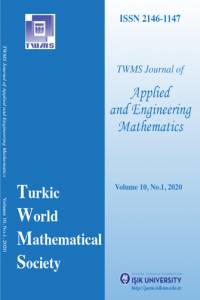COMBINING GENETIC ALGORITHM AND SINC-GALERKIN METHOD FOR SOLVING AN INVERSE DIFFUSION PROBLEM
___
- Cannon,J.R. and Van de Hoek,J., (1982), The one phase stefan problem subject to energy, J. Math. Anal. Appl., 86, pp.281-292.
- Cannon,J.R., Eteva,S.P., and Van de Hoek,J., (1987), A Galerkin procedure for the diffusion equation subject to the specification of mass, SIAM J. Numer. Anal., 24, pp.499-515.
- Cannon,J.R., (1963), The solution of the heat equation subject to the specification of energy, Quart. Appl. Math., 21, pp.155-160.
- Capasso,V. and Kunisch,K., (1988), A reaction-diffusion system arising in modeling manevironment diseases, Quart. Appl. Math., 46, pp.431-450.
- Shidfar,A., Pourgholi,R., and Ebrahimi,M., (2006), A numerical method for solving of a nonlinear inverse diffusion problem, Comput. Math. Appl., 52, pp.1021-1030.
- Dehghan,M., (2001), An inverse problem of finding a source parameter in a semilinear parabolic equation, Appl. Math. Model., 25, pp.743-754.
- Dehghan,M., (2002), Numerical techniques for a parabolic equation subject to an overspecified bound- ary condition, Appl. Math. Comput. 132, pp.299-313.
- Dehghan,M., (2003), Numerical solution of one-dimensional parabolic inverse problem, Appl. Math. Comput., 136, pp.333-344.
- Tatari,M. and Dehghan,M., (2007), Identifying a control function in parabolic partial differential equations from overspecified boundary data, Computers and Mathematics with Applications, 53, pp.1933-1942.
- Beck,J.V., Blackwell,B., and St.Clair,C.R., (1985), Inverse Heat Conduction: IllPosed Problems
- Wiley-Interscience, NewYork. Beck,J.V. and Murio,D.C., (1986), Combined function specification-regularization procedure for solu- tion of inverse heat condition problem, AIAA J., 24, pp.180-185.
- Cabeza,J.M.G., Garcia,J.A.M., and Rodriguez,A.C., (2005), A Sequential Algorithm of Inverse Heat
- Conduction Problems Using Singular Value Decomposition, International Journal of Thermal Sciences, , pp.235-244. Molhem,H. and Pourgholi,R., (2008), A numerical algorithm for solving a one-dimensional inverse heat conduction problem, Journal of Mathematics and Statistics, 4(1), pp.60-63.
- Pourgholi,R., Azizi,N., Gasimov,Y.S., Aliev,F., and Khalafi,H.K., (2009), Removal of Numerical Insta- bility in the Solution of an Inverse Heat Conduction Problem, Communications in Nonlinear Science and Numerical Simulation, 14(6), pp.2664-2669.
- Pourgholi,R. and Rostamian,M., (2010), A numerical technique for solving IHCPs using Tikhonov regularization method, Applied Mathematical Modelling, 34(8), pp.2102-2110.
- Pourgholi,R., Rostamian,M., and Emamjome,M.,(2010), A numerical method for solving a nonlinear inverse parabolic problem, Inverse Problems in Science and Engineering, 18(8), pp.1151-1164.
- Tadi,M., (1997), Inverse Heat Conduction Based on Boundary Measurement, Inverse Problems, 13, pp.1585-1605.
- Shidfar,A., Zolfaghari,R., and Damirchi,J., (2009), Application of Sinc-collocation method for solving an inverse problem,Journal of computational and Applied Mathematics, 233, pp.545-554.
- Cant-Paz,E., (1995), A summary of research on parallel genetic algorithms, IlliGAL Report No 95007
- University of Illinois. Pourgholi,R., Dana,H., and Tabasi,S.H., (2014), Solving an inverse heat conduction problem using ge- netic algorithm: Sequential and multi-core parallelization approach, Applied Mathematical Modelling, Volume 38, Issues 78.
- Pourgholi,R., Molai,A.A., and Houlari,T., (2013), Resolution of an inverse parabolic problem using
- Sinc-Galerkin method, TWMS J. App. Eng. Math.,V2(3), pp.160-181. Lund,J. and Bowers,K., (1991), Sinc Methods for Quadrature and Differential Equations, Siam, Philadelphia, PA.
- Stenger,F., (1979), A Sinc-Galerkin method of solution of boundary-value problems, Math. Comp., , pp.85-109.
- Whittaker,E.T., (1915), On the functions which are represented by the expansions of the interpolation theory, Proc. Roy. Soc. Edinburg, 35, pp.181-194.
- Whittaker,J.M., (1935), Interpolation Function Theory, in: Cambridge Tracts in Mathematics and Mathematical Physics, Vol.33, Cambridge University Press, London.
- Koonprasert,S. and Bowers,K., (2004), The Fully Sinc-Galerkin Method for Time-Dependent Bound- ary Conditions, Numerical Method for Partial Differential Equations, 20(4), pp.494-526.
- Hansen,P.C., (1992), Analysis of discrete ill-posed problems by means of the L-curve, SIAM Rev., 34, pp.561-80.
- Lawson,C.L. and Hanson,R.J., (1995), Solving Least Squares Problems, Philadelphia, PA:SIAM.
- Tikhonov,A.N. and Arsenin,V.Y., (1977), On the solution of Ill-posed problems, New York, Wiley.
- Tikhonov,A.N., and Arsenin,V.Y., (1977), Solution of Ill-Posed Problems, V.H.Winston and Sons, Washington, DC.
- Martin,L., Elliott,L., Heggs,P.J., Ingham,D.B., Lesnic,D., and Wen,X., (2006), Dual Reciprocity
- Boundary Element Method Solution of the Cauchy Problem for Helmholtz-type Equations with Vari- able Coefficients, Journal of sound and vibration, 297, pp.89-105. Elden,L., (1984), A Note on the Computation of the Generalized Cross-validation Function for Ill- conditioned Least Squares Problems, BIT, 24, pp.467-472
- Golub,G.H., Heath,M., and Wahba,G., (1979), Generalized Cross-validation as a Method for Choosing a Good Ridge Parameter, Technometrics, 21(2), pp.215-223.
- Wahba,G., (1990), Spline Models for Observational Data, CBMS-NSF Regional Conference Series in
- Applied Mathematics, Vol.59, SIAM, Philadelphia. Holland,J.H., (1975), Adaptation in Natural and Artificial System, University of Michigan Press, Ann Arbor.
- Liu,F-B., (2008), A modified genetic algorithm for solving the inverse heat transfer problem of esti- mating plan heat source, International Journal of Heat and Mass Transfer, 51, pp.3745-3752.
- Reza Pourgholi, for the photograph and short biography, see TWMS J. Appl. and Eng. Math., V.2, No.2, 2012.
- ISSN: 2146-1147
- Başlangıç: 2010
- Yayıncı: Turkic World Mathematical Society
S. BHAVANARİ, S. DEVANABOİNA, S. P. KUNCHAM
H. JAMALİ, K.h. Shokri TERNONİZ
T.m. ALIYEV, N.a. ALİYEV, V.m. MAMEDOV
